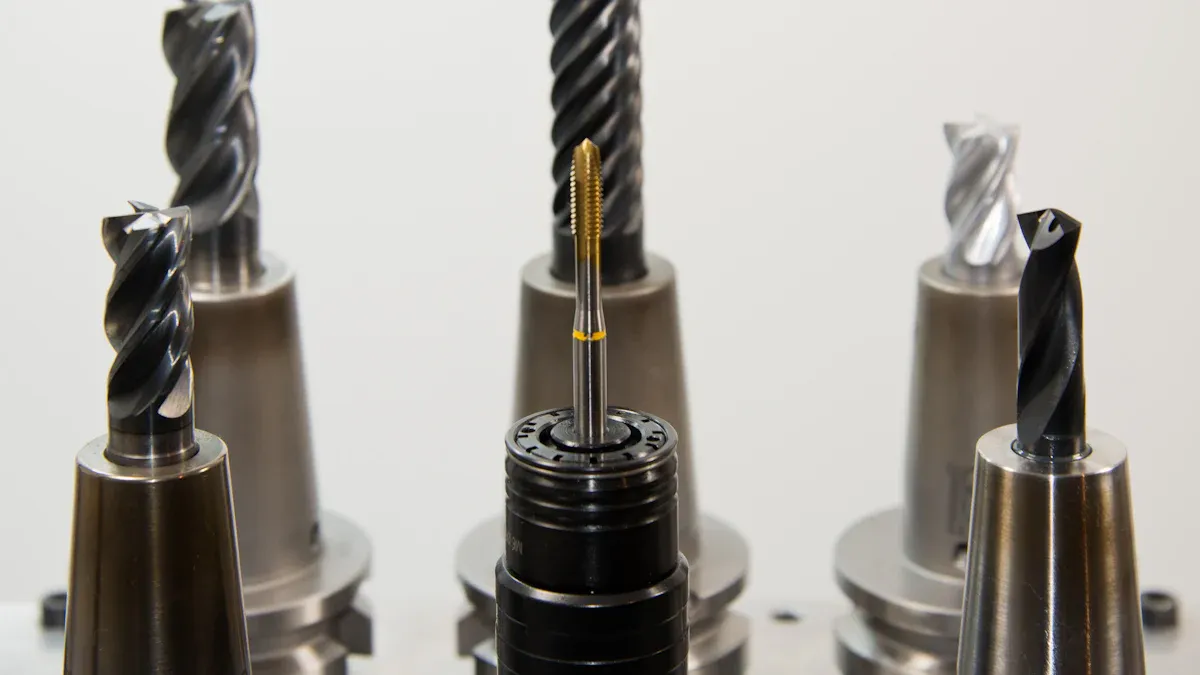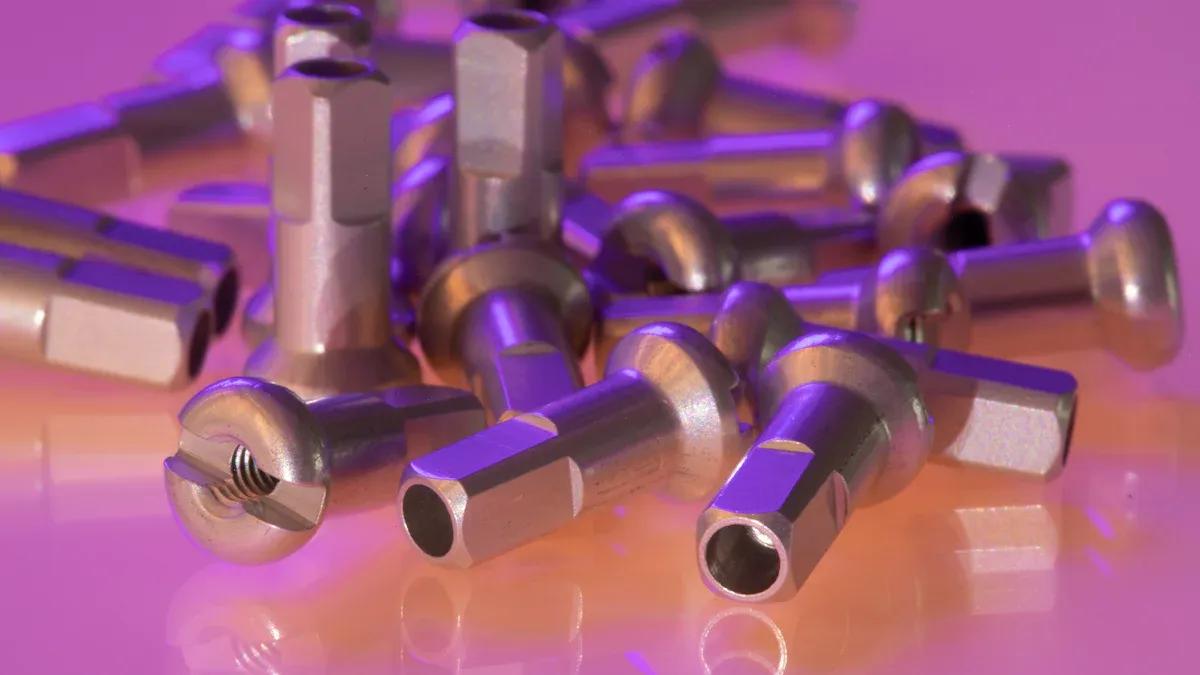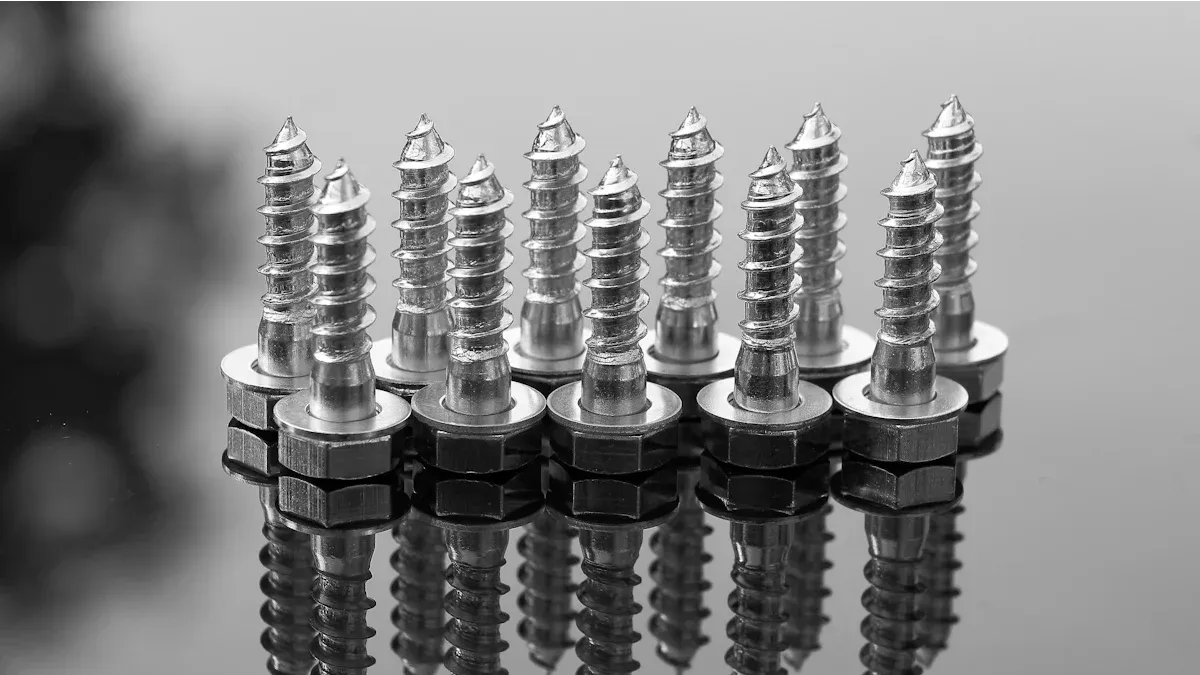A Historical Journey of Nickel Titanium Alloy

Nickel titanium alloy has transformed modern industries with its groundbreaking properties. Its ability to "remember" shapes and return to them after deformation, known as the shape memory effect, has redefined engineering possibilities. Superelasticity, another remarkable feature, allows it to endure significant stress without permanent damage. These characteristics have made it indispensable in fields like medicine, robotics, and aerospace. Engineers and scientists continue to explore its potential, pushing the boundaries of innovation.
Key Takeaways
Nickel titanium alloy, called nitinol, has special traits like shape memory and superelasticity. These make it important in medicine and aerospace.
Nitinol was discovered in 1959 by William J. Buehler and Frederick E. Wang. This was a big step forward in material science, leading to new uses.
Nitinol is safe for the body and lasts a long time. It has changed medical tools, making treatments safer and better.
Even with early problems in making it, research has found more uses for nitinol. This has led to new ideas in many areas.
Nitinol is good for the environment because it can be recycled and creates less waste. This supports global eco-friendly goals.
The Discovery of Nitinol

William J. Buehler and the Naval Ordnance Laboratory
In 1959, William J. Buehler and Frederick E. Wang discovered nickel titanium alloy, later named nitinol, at the Naval Ordnance Laboratory. Their research aimed to develop a durable material for missile nose cones. During their experiments, they identified the alloy's unique ability to return to its original shape after deformation. This discovery marked the beginning of the history of nitinol. In 1961, Buehler presented a sample of the alloy at a laboratory meeting. He demonstrated its shape memory effect by heating the deformed material, which amazed his colleagues. This breakthrough laid the foundation for further exploration of nitinol's properties.
The Role of the 1960s Space Race
The 1960s space race played a significant role in advancing nitinol research. The demand for innovative materials in aerospace engineering drove scientists to explore alloys with exceptional properties. Nitinol's ability to withstand extreme conditions made it a promising candidate for space applications. Its superelasticity and shape memory effect aligned perfectly with the needs of the era. Researchers believed that nitinol could revolutionize spacecraft components, leading to increased interest in its development. This period highlighted the importance of nitinol in pushing technological boundaries.
Naming and Initial Observations
The name "nitinol" reflects its composition and origin. It combines "Ni" for nickel, "Ti" for titanium, and "NOL" for the Naval Ordnance Laboratory. Early observations of nitinol revealed its remarkable properties, such as the shape memory effect and superelasticity. These features distinguished it from other materials and sparked curiosity among scientists. The initial findings demonstrated nitinol's potential to transform industries, marking a pivotal moment in its history.
"The discovery of nitinol was not just a scientific breakthrough; it was a testament to human ingenuity and the pursuit of innovation."
Year | Event | Key Figures |
|---|---|---|
1959 | Discovery of nitinol properties | William J. Buehler, Frederick E. Wang |
1961 | Presentation of alloy sample | William J. Buehler |
1980s | Commercialization efforts begin | N/A |
Properties of Nickel Titanium Alloy
Shape Memory Effect
The shape memory effect is one of the most remarkable properties of nickel titanium alloy. This phenomenon allows the material to return to its original shape after being deformed. When heated above a specific temperature, the alloy undergoes a phase transformation that restores its initial form. This unique behavior makes it a shape memory alloy, setting it apart from conventional materials.
Scientists have extensively studied this effect to understand its potential applications. For example, engineers use it in medical devices like stents and surgical tools. These devices can be deformed for easy insertion and then regain their shape once inside the body. The shape memory effect has also found use in robotics, where it enables components to perform precise movements.
"The shape memory effect is not just a scientific curiosity; it is a game-changer in modern engineering."
Superelasticity and Transition Temperature
Nickel titanium alloy exhibits superelasticity, another extraordinary property. This allows the material to endure significant stress without permanent deformation. Unlike traditional metals, it can stretch and bend while returning to its original shape. This behavior occurs due to a reversible phase transformation triggered by mechanical stress.
The transition temperature plays a critical role in determining when the alloy exhibits superelasticity or the shape memory effect. Below this temperature, the material behaves differently, making it essential to tailor the alloy for specific applications. For instance, in orthodontics, superelastic wires are used to apply consistent pressure on teeth, improving treatment efficiency.
Biocompatibility and Durability
Nickel titanium alloy is highly biocompatible, making it ideal for medical applications. Its ability to interact safely with human tissues has revolutionized healthcare. Devices like implants, stents, and surgical instruments benefit from this property. Additionally, the alloy's durability ensures long-term performance, even in challenging environments.
Its resistance to corrosion further enhances its reliability. This makes it suitable for use in harsh conditions, such as aerospace and marine industries. The combination of biocompatibility and durability has solidified nickel titanium alloy's position as a versatile material in various fields.
Early Challenges in Nitinol Development
Manufacturing and Cost Barriers
The early development of nitinol faced significant manufacturing challenges. Producing the alloy required precise control of its nickel and titanium composition. Even minor deviations could affect its unique properties, such as the shape memory effect and superelasticity. Manufacturers struggled to maintain consistency, which limited its reliability in practical applications.
The production process also demanded advanced equipment and expertise, making it expensive. Many industries hesitated to invest in nitinol due to its high cost compared to traditional materials. This financial barrier slowed its adoption and limited its availability for large-scale use.
"The complexity of nitinol's production process initially overshadowed its potential, delaying its widespread acceptance."
Misconceptions and Limited Adoption
Misconceptions about nitinol's reliability further hindered its early adoption. Concerns about fatigue failures and nickel release raised doubts about its safety and durability. These issues discouraged industries from exploring its applications. However, advancements in processing techniques and ongoing research gradually addressed these concerns.
The table below highlights some of the early challenges and the solutions that emerged over time:
Challenges in Nickel Titanium Adoption | Solutions and Advancements |
|---|---|
Fatigue failures | Advancements in processing techniques |
Concerns about nickel release | Ongoing research addressing reliability |
Difficulties in manufacturing | Investments in advanced equipment |
These efforts helped dispel misconceptions and demonstrated nitinol's potential as a reliable material.
Decline in Public and Industrial Interest
Despite its promising properties, nitinol experienced a decline in interest during its early years. Industries viewed it as a niche material with limited applications. The high costs and technical challenges overshadowed its benefits. Public awareness of nitinol remained low, as its applications were not yet widespread.
This period of stagnation delayed the alloy's integration into mainstream industries. However, the groundwork laid during this time eventually paved the way for its resurgence in later decades.
"The early struggles of nitinol highlight the importance of perseverance in scientific innovation."
Resurgence and Applications of Nickel Titanium Alloy

Medical Innovations and Orthodontics
Nickel titanium alloy has revolutionized the medical field, particularly in devices requiring precision and adaptability. Its biocompatibility and superelasticity make it ideal for stents, surgical instruments, and orthodontic tools. For example, orthodontic wires made from this alloy apply consistent pressure to teeth, improving alignment over time. In endodontics, flexible root canal files crafted from nickel titanium alloy navigate complex tooth structures with ease, reducing the risk of damage.
Cardiovascular devices also benefit from this alloy's unique properties. Stents and catheters conform to the body's contours, ensuring effective treatment. The alloy's durability and resistance to fatigue enhance the reliability of these life-saving devices.
Application Area | Key Properties | Examples of Use |
|---|---|---|
Medical Devices | Superelasticity, Shape Memory, Biocompatibility | Stents, Surgical Instruments, Orthodontic Tools |
Endodontics | Flexibility, Durability | Root Canal Files |
Cardiovascular Devices | Resilience, Conformity to Body Contours | Stents, Catheters |
"The versatility of nickel titanium alloy has made it a cornerstone of modern medical advancements."
Consumer Products and Eyewear
The consumer market has embraced nickel titanium alloy for its durability and flexibility. Eyewear frames made from this material can bend without breaking, offering both comfort and resilience. These frames return to their original shape after deformation, making them ideal for daily use.
In addition to eyewear, the alloy is used in other consumer products requiring strength and adaptability. For instance, it is found in high-performance sports equipment and innovative household tools. Its ability to withstand repeated stress without losing functionality has made it a preferred choice for manufacturers.
Aerospace and Robotics Advancements
Nickel titanium alloy has played a pivotal role in aerospace and robotics. Its ability to undergo significant elastic deformations makes it suitable for components exposed to extreme conditions. Early applications included hydraulic line couplings in military aircraft, where the alloy's reliable actuation characteristics proved invaluable.
Advancements in the understanding of martensitic transformations during the 1980s and 1990s improved the alloy's fatigue life and corrosion resistance. These developments expanded its use in aerospace, where durability and performance are critical.
In robotics, nickel titanium alloy enables precise movements and adaptability. Its shape memory effect allows robotic components to perform complex tasks, such as gripping delicate objects or operating in confined spaces. These properties have made it indispensable in advancing robotic technologies.
"The unique properties of nickel titanium alloy continue to drive innovation in aerospace and robotics, shaping the future of these industries."
The Future of Nitinol
Emerging Technologies and Research
Nickel titanium alloy continues to inspire innovation in various fields. Researchers are exploring its potential in wearable medical devices and robotic surgical tools. These advancements aim to harness the alloy's biocompatibility and shape memory properties for cutting-edge healthcare solutions. Ongoing studies focus on enhancing its performance, ensuring it meets the demands of modern medical technologies.
Key areas of research include:
Wearable medical devices: Flexible and adaptive materials for monitoring and treatment.
Robotic surgical tools: Precision instruments that conform to body contours.
Improved biocompatibility: Reducing adverse reactions in medical applications.
The table below highlights recent experimental findings and their implications:
Application Area | Key Properties and Benefits |
|---|---|
Cardiovascular Devices | Self-expanding stents adapt to body contours; braided stents enhance flexibility and durability; guidewires offer exceptional maneuverability. |
Orthodontic Tools | Wires exert consistent pressure for effective alignment; superelasticity reduces adjustment frequency; biocompatibility ensures safety. |
Surgical Instruments | Instruments conform to body contours for minimally invasive procedures; corrosion resistance ensures reliability; biocompatibility minimizes adverse reactions. |
Other Medical Applications | Used in endodontics for flexible root canal files; orthopedic implants provide stability and promote healing; corrosion resistance ensures long-term reliability. |
The ongoing research into nickel titanium alloy demonstrates its potential to revolutionize healthcare and other industries.
Sustainability and Environmental Impact
Nickel titanium alloy offers significant sustainability benefits. Its durability reduces the need for frequent replacements, minimizing waste. Optimized designs ensure efficient resource use, while its resistance to extreme conditions promotes cleaner industrial environments. Additionally, the alloy's recyclability supports a circular economy, making it an environmentally friendly choice.
Sustainability Benefit | Description |
|---|---|
Enhanced Durability | Reduces the need for frequent replacements, thereby decreasing waste generation. |
Optimized Design | Ensures efficient resource use, minimizing material required without compromising performance. |
Resistance to Extreme Conditions | Contributes to reducing toxic waste, promoting a cleaner and safer industrial environment. |
Ease of Recycling | Supports a sustainable approach by facilitating the recycling process. |
Business Competitiveness | Optimizes resources and reduces long-term costs, enhancing competitiveness in the market. |
Contribution to Circular Economy | Positions metals and alloys as essential elements in the future circular economy. |
By addressing environmental challenges, nickel titanium alloy aligns with global sustainability goals.
Expanding Industrial Applications
The versatility of nickel titanium alloy ensures its expanding role across industries. In medicine, it enables the creation of innovative devices like temperature-sensitive actuators for drug delivery systems. These devices improve treatment outcomes for chronic conditions. The alloy's flexibility also allows for intricate designs in stents and orthodontic wires, enhancing patient comfort.
In aerospace, nickel titanium alloy is used in components requiring high strength and flexibility. Its ability to withstand extreme conditions makes it ideal for critical applications. The automotive industry benefits from its use in actuators and sensors, while the electric power sector relies on its reliability under stress.
Key applications include:
Medical Devices: Orthodontic and medical implants.
Aerospace: High-performance components.
Automotive: Advanced actuators and sensors.
Electric Power: Systems requiring durability and precision.
The growing demand for nickel titanium alloy highlights its importance in shaping the future of technology and industry.
Nickel titanium alloy, discovered in 1959 by William J. Buehler and Frederick E. Wang, has left an indelible mark on modern technology. Initially developed for missile nose cones, its unique properties, such as the shape memory effect and superelasticity, astonished researchers when a heated sample returned to its original form. Despite early challenges in processing, the alloy's potential became evident by the 1980s. Today, nitinol drives innovation across industries, from medicine to aerospace. Its transformative role underscores its importance in shaping the future of engineering and technology.
Nickel titanium alloy exemplifies how scientific breakthroughs can redefine possibilities and inspire progress.
FAQ
What makes nickel titanium alloy unique compared to other materials?
Nickel titanium alloy stands out due to its shape memory effect and superelasticity. These properties allow it to return to its original shape after deformation and endure significant stress without permanent damage. Its biocompatibility and corrosion resistance further enhance its versatility across industries.
How is nickel titanium alloy used in medical applications?
Medical professionals use nickel titanium alloy in stents, orthodontic wires, and surgical instruments. Its biocompatibility ensures safe interaction with human tissues, while its flexibility and durability improve device performance. These qualities make it indispensable in modern healthcare innovations.
Why was nitinol initially challenging to manufacture?
Early manufacturing faced difficulties due to the alloy's sensitivity to composition. Small deviations in the nickel-titanium ratio affected its properties. Additionally, the production process required advanced equipment and expertise, which increased costs and limited its early adoption.
Can nickel titanium alloy be recycled?
Yes, nickel titanium alloy is recyclable. Its durability and resistance to wear reduce waste, while its recyclability supports sustainable practices. These features align with global efforts to promote environmentally friendly materials in industrial applications.
What industries benefit most from nickel titanium alloy?
Industries like medicine, aerospace, and robotics benefit significantly from nickel titanium alloy. Its unique properties enable precise movements in robotics, reliable performance in aerospace components, and adaptable designs in medical devices, making it a versatile material for innovation.
See Also
Exploring Current Innovations in Nickel Titanium Alloy Applications
Understanding Nickel Titanium's Role in Healthcare Solutions
Improving Catheter and Implant Function with Nickel-Titanium Tubing
Why Laser Cutting is Perfect for Nickel-Titanium Medical Tools
Strategies for Tackling Nickel-Titanium Laser Micromachining Issues

